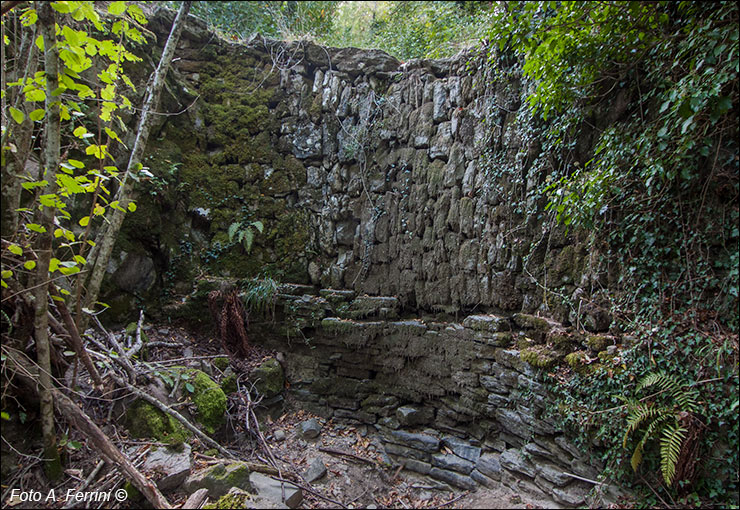Sulla via del ferro e della transumanza
itinerario sulle pendici sud Pratomagno da Pontenano al Passo della Crocina
Italiano
IN CAMMINO SU UNA VIA DELLA TRANSUMANZA 31
Vista dal basso del muro a secco che sostiene l'antica strada tra Pontenano e il Passo della Crocina nel punto dove questa è attraversata dal Fosso della Villa. Questa "infrastruttura viaria", certamente molto antica, ma che è difficile dargli una datazione precisa, è stata il frutto di un grosso lavoro preceduto da un meticoloso progetto. La parte bassa, più sporgente e sicuramente molto spessa, è costituita da un pietrame, a mo' di lastre, sistemato in orizzontale. Questa funge da robusto appoggio capace di sopportare una forte spinta verticale. Nella parte alta del muro, invece, vediamo pietre, sempre a mo' di spesse lastre, sistemate in verticale. Una muratura chiamata "a spina" che, data la forma arcuata perché segue la linea della sovrastante curva, è stata in grado di reggere la forte spinta laterale del terreno e, negli ultimi decenni, anche quella dei pesanti mezzi motorizzati che sono transitati sulla strada. Il risultato di tutto questo è che dopo diversi secoli il muro non mostra un minimo segno di cedimento, non si è mossa una sola pietra. Di acqua ce n'è passata tanta, ma non ci sono erosioni evidenti.
View from below of the dry stone wall that supports the ancient road between Pontenano and the Crocina Pass at the point where it is crossed by the Fosso della Villa. This "road infrastructure", certainly very ancient, but which is difficult to give a precise dating to, was the result of a great deal of work preceded by a meticulous project. The lower part, more protruding and certainly very thick, is made up of stones, like slabs, arranged horizontally. This acts as a sturdy support capable of withstanding a strong vertical thrust. In the upper part of the wall, however, we see stones, again like thick slabs, arranged vertically. A masonry called "spine" which, given its arched shape because it follows the line of the curve above, has been able to withstand the strong lateral thrust of the ground and, in recent decades, also that of the heavy motorized vehicles that have passed on the road . The result of all this is that after several centuries the wall does not show the slightest sign of failure, not a single stone has moved. A lot of water has passed through, but there is no obvious erosion.



















































































